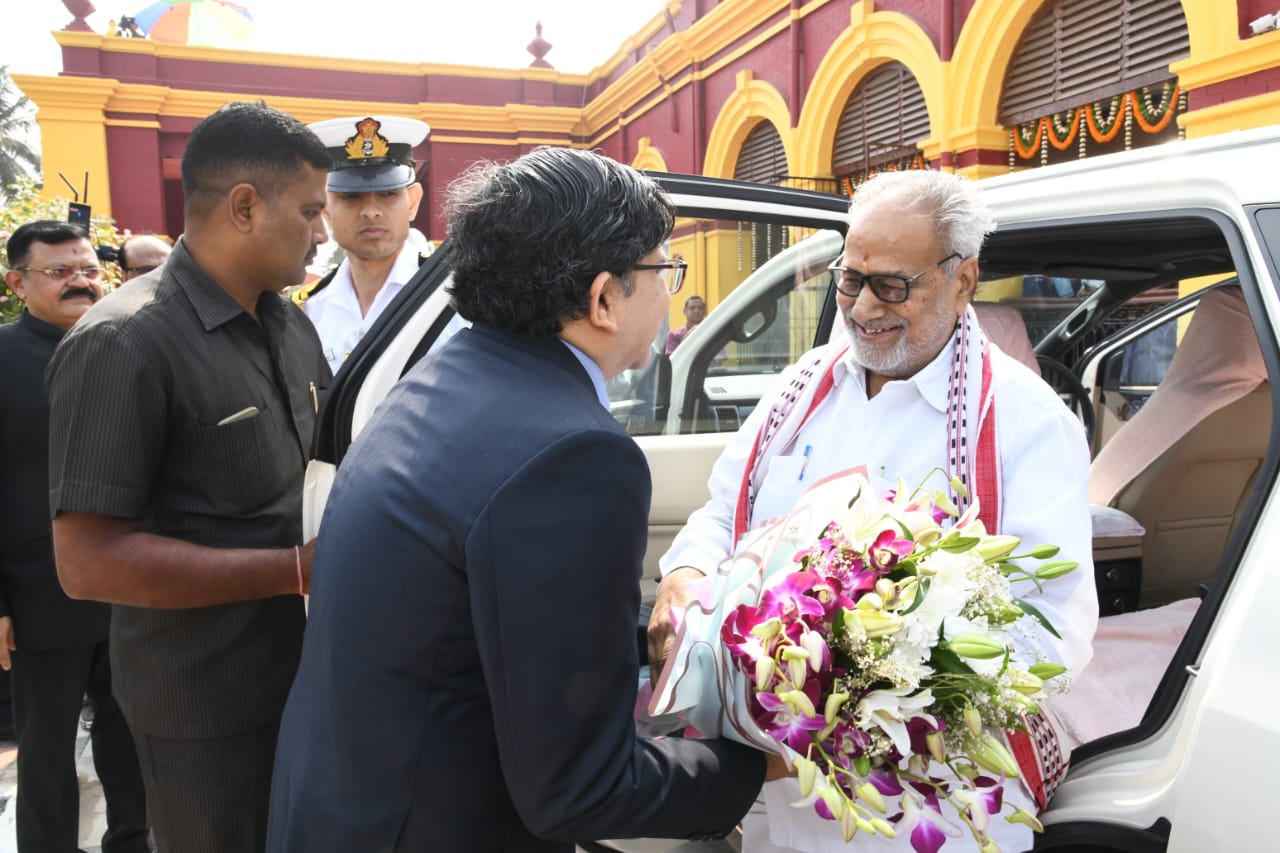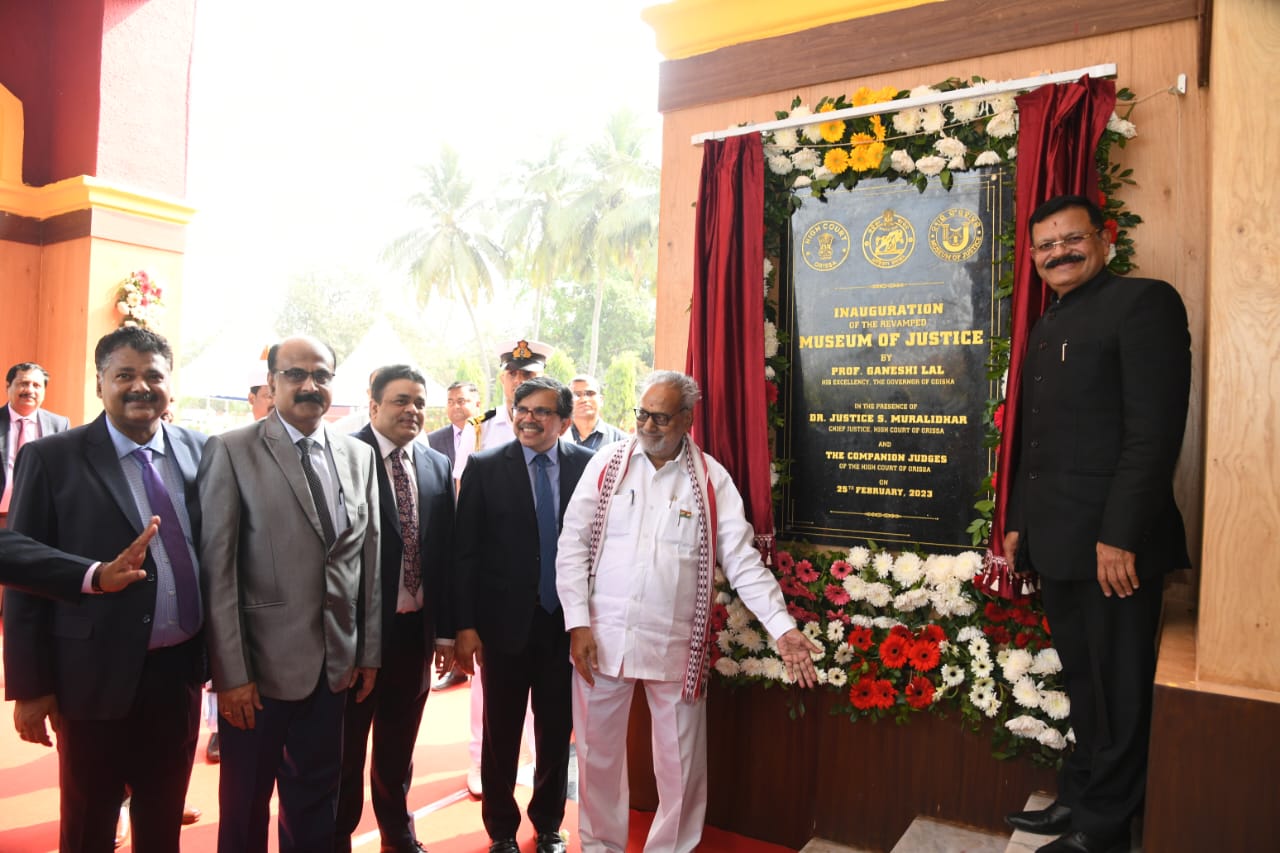Cuttack: The refurbished Museum of Justice inside the Barabati Quila, Cuttack was inaugurated by Professor Ganeshi Lal, Governor of Odisha on Saturday in the presence of Dr. Justice S. Muralidhar, Chief Justice and the Judges of the High Court of Orissa.
Former Chief Justice of India Justice G.B. Patnaik, former Judges of the High Court, Advocate General, Bar members and senior Government officials attended the inaugural function. Members of the Consultative Committee of the Museum Dr. Justice A.K. Misra, Historian Dr Nivedita Mohanty, A.B. Ota, Director, Tribal Museum, Prof Nihar Ranjan Pattnaik, Suchismita Mantry, Deputy Director, Odia Language and Culture and Mallika Mitra, Director, INTACH were present on the occasion. Among others, students and teachers of Madhusudan Law University, University Law College and Ravenshaw University were also present.
Presenting the welcome address Justice Debabrata Dash said that Odisha has a rich heritage of justice delivery system and the Museum of Justice showcases its glorious history from ancient period. Justice Dash said the Museum of Justice could be possible due to the vision of the Chief Justice.
Speaking on the occasion the Chief Justice Dr. S. Muralidhar said that history has not only been honored but also been created through the Museum of Justice. The Chief Justice said that the Record Rooms of the High Court and District Courts containing old records dating back to 19th Century were the real trigger behind the thought to rejuvenate the High Court Museum as the Museum of Justice. He added, so many stories of Odisha- the stories of freedom fighters, famous personalities and events lay hidden in these records and the High Court has decided to showcase them in the Museum of Justice and to present before the public the evolution of legal system of Odisha. The Chief Justice said that the Museum will reflect not only the legal system of Odisha but also that of the entire country because Odisha mirrors what is happening elsewhere. He expressed hope that the Museum of Justice would be a place of learning, research, co-mingling and teaching. The Chief Justice thanked the RRDC Committee and the Consultative Committee for their guidance in shaping the Museum of justice and also lauded the efforts of all others who had contributed for it.
Delivering the keynote address Professor Ganeshi Lal, the Governor of Odisha applauded the initiative and said that the Museum of Justice is a matter of pride for the entire country. The Governor stressed upon the need of awareness in every action for upholding righteousness and complimented the judiciary for upholding righteousness in true sense. The Governor expressed hope that the Museum of Justice would enrich the future generations. Proposing vote of thanks Justice Sashikanta Mishra said that the Museum of Justice reflects the deep sense of commitment of Dr. S. Muralidhar towards the State of Odisha and its people. He thanked the State Government and all other agencies for the support in rejuvenation of the Museum and its peripheral area. The first publication of the Museum of Justice was released in the inaugural function which contains information on the rejuvenation of the Museum. After the inaugural function the students visited the galleries of the Museum and were found excited. Sharing their experience the students said that they found the galleries on the Tribal Justice System, the Mock Courtroom and the Judgments interesting and educative.
Inception of the Museum
A museum not only educates the future generations but also brings communities together acquainting them with their shared past. Realizing the need to cherish the rich heritage of Odisha’s legal system and presenting it before the coming generations, the High Court of Orissa decided to establish a museum. On 12th November 2017 the ‘Orissa High Court Museum’ was established in the heritage residential building of the Chief Justice in Barabati Quila, Cuttack. It was inaugurated by Justice Dipak Misra, the then Chief Justice of India, Justice Vineet Saran, the then Chief Justice of the High Court and the Judges of the High Court. Documents relating to the High Court’s establishment, old books and judgements, antique objects collected from various district courts and rare photographs were displayed for public view.
Transformation into Museum of Justice Before establishment of the High Court of Orissa in 1948, the Odisha province was within the jurisdiction of the High Court of Calcutta from 1862 to 1912 and the High Court of Patna from 1912 to 1948. The southern part of the province was within the jurisdiction of the Madras High Court. Therefore, the repository of case records of the High Court of Orissa includes the old judicial records of the three High Courts: at Calcutta, Patna and Madras. They also include records belonging to erstwhile High Courts of the princely states of Odisha. In 2021, after Dr. S. Muralidhar took over as Chief Justice of the High Court of Orissa, he initiated efforts to streamline the judicial record rooms across the state. He visited the district courts of all the 30 districts. The Record Room Digitization Centre (RRDC) of the High Court was established in Cuttack. On the same lines, four District Court Digitization Centres (DCDCs) were established. In October, 2022 ten District Court Digitization Hubs (DCDHs) were established at district level. In the process records dating back to 19th century in the High Court and District Courts were unearthed. These records appeared to have a treasure of historical information. This led to conception of an idea of having a project for documenting the judicial history of Odisha. The Chief Justice conceived the idea of setting up a Centre for Judicial Archives for preservation of the old records. He also mooted the idea of a modern museum to showcase the heritage of the Odisha judiciary. The Chief Justice wrote to the Chief Minister on 25th March, 2022 proposing the establishment of a Centre for Judicial Archives and revamping of the existing High Court Museum as a ‘Museum of Justice’. By his letter dated 2nd April, 2022 the Chief Minister assured support of the State Government. The first limb of the project, the Centre for Judicial Archives was established on 1st May, 2022, where the conservation of the old fragile records using scientific techniques commenced. The preserved documents of historical value were proposed to be showcased in the museum. The idea was to transform the existing museum from a repository of antiquities into a centre for education and research- an intellectual 4 destination which would create a stored cultural and social space, for historians, legal academics, researchers and students. It would also showcase the Tribal Justice System acknowledging that Scheduled Tribes constitute a sizeable percentage of Odisha’s population. Hence, it was rechristened as a ‘Museum of Justice’ to make it more broad and themebased. Massive changes were proposed to its composition. Before embarking upon the project it was necessary to understand the collection, storage, conservation and exhibition protocols required in a museum. Therefore, the Chief Justice Dr. S. Muralidhar, Justice Sashikanta Mishra and Dr Lalatendu Das Mohapatra, Director cum OSD of the Centre of Judicial Archives visited the Indian Museum, the Victoria Memorial and the Police Museum in Kolkata, the Bihar and Patna Museums in Patna and the Government Museum in Chennai. Later, Justice Sashikanta Mishra and Dr Lalatendu Das Mohapatra also visited the National Museum, the National Archives, the Delhi State Archives at Delhi and the Asiatic Society, the Centre for Studies in Social Sciences and the West Bengal State Archives at Kolkata. A video meeting was also held with experts of the British Library, London. Besides, Dr. Das Mohapatra visited the courts in Berhampur, Aska, Puri, Bhadrak, Balasore, Baripada, Keonjhar and Dhenkanal to locate antique objects and old records for showcasing in the museum. In the process, about 50 antique objects and a few old records were located and shortlisted. The six judges committee comprising Justice Debabrata Dash, Dr. Justice Sanjeev Kumar Panigrahi, Justice Mruganka Shekhar Sahoo, Justice Biraja Prasad Satapathy, Justice Sashikanta Mishra and Justice Sanjay Kumar Mishra took up supervision of the Record Room Digitization Centre, Centre for Judicial Archives and Museum of Justice. A separate post of Registrar (Records) was created to oversee the work and a judicial officer in the rank of District Judge, Shri Abhilas Senapati was posted who works in coordination with Dr Lalatendu Das Mohapatra, Director Cum OSD. Conservation work in the Centre for Judicial Archives and 5 refurbishment of Museum of Justice was entrusted to Indian National Trust for Art and Culture (INTACH) who has the expertise in conserving, repairing, redesigning the cultural heritages.





Comments are closed.